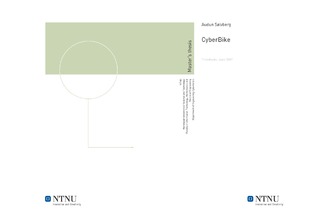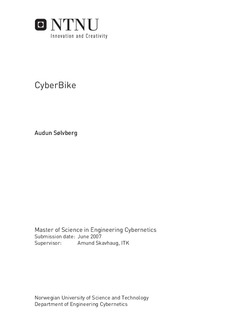| dc.description.abstract | The idea about the CyberBike came to Jens G. Balchen - the founder of the Department of Engineering Cybernetics (ITK) at NTNU - in the 1980's. He wanted to make an unmanned autonomus bicycle, i.e. a bike that could run by itself. The idea was picked up by Amund Skavhaug, who started the CyberBike project in the late 80's. After being deffered for some years, the CyberBike has again gained some attention. This master's thesis is based on Hans Olav Loftum's and Lasse Bjermeland's theses at the spring 2006 and the autumn project of John A. Fossum the same year. The goal of the CyberBike project is to make the bike work as intended, i.e. as an autonomous unmanned bicycle. This thesis naturally share this goal, although the bike did not become able to take its first autonomous trip within the thesis' time frame. At the start of the work, the bike were already equipped with a suitcase of computational hardware on its baggage rack, a small QNX Neutrino OS image was installed on the industrial PC mounted in the suitcase, and drivers for the installed motors, tachometers and potmeters were written. An Inertial Measurement Unit (IMU) was intended to supply the control system with the necessary information about rotation, acceleration and position, and the unit was purchased for the purpose. Also a driver was written, but not properly tested. The IMU had to be installed and connected to the control system. The bike's control theory was developed, but had never been put into action outside computer simulations (due to the lack of acceleration measurements). The various tasks that had to be addressed emerged as the development process advanced. First, the IMU had to be connected to the system, by making a signal tranceiver circuit. A small printed circuit board was designed and laid out, mainly to include a MAX233CPP iC. Then the DB-9 serial connector on the bikes single board computer (Wafer-9371A) could be used to read the UART signal from the IMU as RS-232. Then some testing had to be done, and drivers updated. A better and more advanced IMU (referred to as the "MTi") was added to the project. This unit needed no signal converting circuitry, but driver development and testing still had to be done. To enhance the CyberBike's navigation opportunities, a GPS module was purchased. A signal transceiving circuit, similar to the one for the IMU, was made for this unit, as well as software to read out the measurements from the device. By the end of this thesis, no navigational algorithms are made, hence the GPS is currently not used, but available for future efforts made on this area. Some hardware related tasks was carried out, as connecting and implementing functionality to the pendulum limit switches, installation of a emergency stop switch and a power switch, purchasing and installation of two 12V batteries and a cooling fan. An operating system upgrade resulted in replacing the CyberBikePC's storage device, a compact flash card, with a mobile hard disk drive. Installation of a motor, for supplying torque to the rear wheel, included setup and tuning of a hardware based velocity controller in a Baldor TFM 060-06-01-3 servo module. However; this task is not to be considered as accomplished, due to some unsolved problems on the system I/O-card's output channels giving the motor controller card its reference voltage. A bike model and controller realized in Simulink was made by Bjermeland. Hence communicaton between Simulink and the device drivers had to be established, and this was realized by using S-functions and Real-Time Workshop. Finally the controller could be connected to the actual bike, but there was too little time left to explore this thoroughly, and make the system work properly. However, a foundation is laid for further development of the control strategy, hopefully storing a bright future for the CyberBike. | nb_NO |

